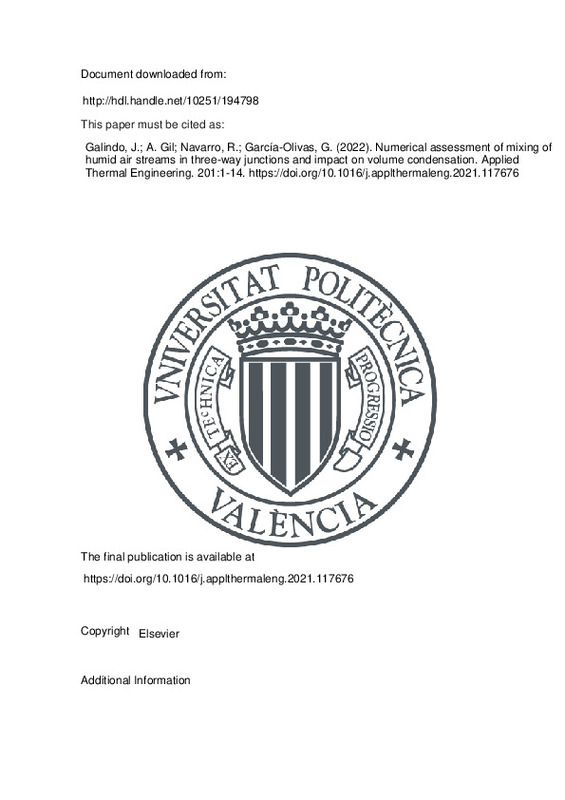JavaScript is disabled for your browser. Some features of this site may not work without it.
Buscar en RiuNet
Listar
Mi cuenta
Estadísticas
Ayuda RiuNet
Admin. UPV
Numerical assessment of mixing of humid air streams in three-way junctions and impact on volume condensation
Mostrar el registro sencillo del ítem
Ficheros en el ítem
| dc.contributor.author | Galindo, José
|
es_ES |
| dc.contributor.author | A. Gil
|
es_ES |
| dc.contributor.author | Navarro, Roberto
|
es_ES |
| dc.contributor.author | García-Olivas, Guillermo
|
es_ES |
| dc.date.accessioned | 2023-07-10T18:03:12Z | |
| dc.date.available | 2023-07-10T18:03:12Z | |
| dc.date.issued | 2022-01-25 | es_ES |
| dc.identifier.issn | 1359-4311 | es_ES |
| dc.identifier.uri | http://hdl.handle.net/10251/194798 | |
| dc.description.abstract | [EN] Flow mixing at three-way junctions is widely studied due to its usage in countless applications. Particularly, in air conditioning and internal combustion engines, the mixing of humid air streams can lead to volume condensation, provided that any local temperature achieves dew conditions. This work investigates and quantifies the correlation between mixing intensity and generated condensation. A method to define mixing indexes is developed, comparing its performance against literature references that employ temperature or passive scalar to evaluate mixing. A numerical campaign of 128 Reynolds-Averaged Navier Stokes three-dimensional (3D) simulations is designed to explore different junction operating conditions. A validated condensation submodel embedded in the 3D model enables the quantification of condensation at the junction outlet, which also can be estimated by means of a 0D model that provides the psychrometric state of a homogeneous mixture between the inlet streams. A strong linear correlation is found between condensation and the product of mixing indexes and 0D condensation mass flow rate, since the latter carries the psychrometric information of the working point. This connection allows to find junction design guidelines to reduce mixing and therefore condensation. Additional simulations confirm that removing junction valves, reducing mixing length, increasing the branch duct diameter and aligning the branch leg with the outlet duct significantly decrease condensation. In the framework of low pressure exhaust gas recirculation (EGR), this condensation damages the compressor wheel. If junctions are designed as suggested, the current constraints over EGR rates to limit condensation can be removed, which will result in internal combustion engines with lower emissions and better fuel consumption. | es_ES |
| dc.description.sponsorship | The authors of this paper wish to thank Andrea Conchado for helping with the fractional factorial design of the numerical campaign and Francisco Moya for his support with the 0D condensation model. This work has been partially supported by ``Conselleria de Innovación, Universidades, Ciencia y Sociedad Digital de la Generalitat Valenciana¿¿ through grant number GV/2020/008. | es_ES |
| dc.language | Inglés | es_ES |
| dc.publisher | Elsevier | es_ES |
| dc.relation.ispartof | Applied Thermal Engineering | es_ES |
| dc.rights | Reserva de todos los derechos | es_ES |
| dc.subject | Volume condensation | es_ES |
| dc.subject | CFD | es_ES |
| dc.subject | Three-way junction | es_ES |
| dc.subject | Mixing index | es_ES |
| dc.subject | Momentum ratio | es_ES |
| dc.subject | Low-pressure exhaust gas | es_ES |
| dc.subject | Recirculation | es_ES |
| dc.subject.classification | MAQUINAS Y MOTORES TERMICOS | es_ES |
| dc.title | Numerical assessment of mixing of humid air streams in three-way junctions and impact on volume condensation | es_ES |
| dc.type | Artículo | es_ES |
| dc.identifier.doi | 10.1016/j.applthermaleng.2021.117676 | es_ES |
| dc.relation.projectID | info:eu-repo/grantAgreement/GENERALITAT VALENCIANA//GV%2F2020%2F008//ANALISIS Y MODELADO DE LA CONDENSACION EN LA LINEA DE EGR DE BAJA PRESION EN UN MOTOR DE AUTOMOCION EN CONDICIONES DE BAJA TEMPERATURA/ | es_ES |
| dc.rights.accessRights | Abierto | es_ES |
| dc.contributor.affiliation | Universitat Politècnica de València. Escuela Técnica Superior de Ingeniería del Diseño - Escola Tècnica Superior d'Enginyeria del Disseny | es_ES |
| dc.description.bibliographicCitation | Galindo, J.; A. Gil; Navarro, R.; García-Olivas, G. (2022). Numerical assessment of mixing of humid air streams in three-way junctions and impact on volume condensation. Applied Thermal Engineering. 201:1-14. https://doi.org/10.1016/j.applthermaleng.2021.117676 | es_ES |
| dc.description.accrualMethod | S | es_ES |
| dc.relation.publisherversion | https://doi.org/10.1016/j.applthermaleng.2021.117676 | es_ES |
| dc.description.upvformatpinicio | 1 | es_ES |
| dc.description.upvformatpfin | 14 | es_ES |
| dc.type.version | info:eu-repo/semantics/publishedVersion | es_ES |
| dc.description.volume | 201 | es_ES |
| dc.relation.pasarela | S\449305 | es_ES |
| dc.contributor.funder | GENERALITAT VALENCIANA | es_ES |
| dc.subject.ods | 13.- Tomar medidas urgentes para combatir el cambio climático y sus efectos | es_ES |







![[Cerrado]](/themes/UPV/images/candado.png)

